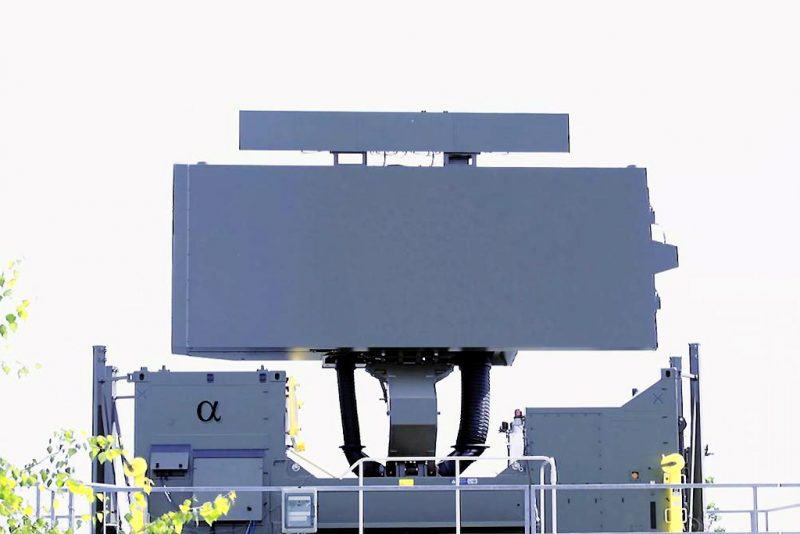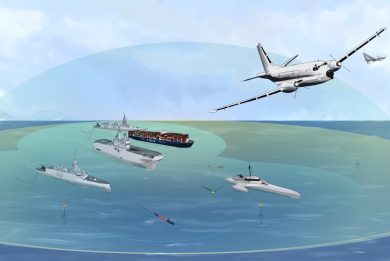Thales introduces its new Ground Master 400 Alpha
By Paolo Valpolini
With over 75 Ground Master 400 3D long range radars sold to around 17 different nations, Thales further evolved its system in order to cope with new scenarios. “In the last few years we have seen a big evolution of air surveillance needs with new types of targets . The emergence of drones is of course one of the biggest challenges, while at the same time in many parts of the world face regular testing of their airspace protection, with unidentified flights mixed into a dense civilian traffic, and the environment is also becoming harder due i.e to the deployment of large land and maritime wind farms, which do not ease the acquisition of potential targets,” Pierre Andurand, head of the Ground Master product family, explains. To cope with those situations Thales carried out an improvement programme that led to the Ground Master 400 Alpha, a new member of the Ground Master family with greater capabilities in terms of detection and identification, it is capable to pick-up targets such as Class 2 and above rotary and fixed wing tactical drones flying at low altitude, around 150 meters over the ground, that systems available could hardly find due to the clutter, providing a greater instrumented range compared to its predecessor, which provided a superior situational awareness to air defence command and control systems.
All this was done with minimal hardware changing, the Ground Master 400 Alpha maintains many commonalities with the Ground Master 400, most of the improvements coming from software development. “In fact transmitter-receiver modules are identical, hence the power emitted as well as the power consumption remain the same, the instrumented detection range having however been increased by 10% from 470 km up to 515 km thanks to a considerable work done on software, as well as to the increased computing power. The latter comes from the adoption of the new digital hardware processor named CPU rack, which allows to compute five times the data of the GM 400, which allow improving detection in complex situations thanks to the increased number of data considered and the capability to implement advanced algorithms,” Thomas Desert, project line manager for the Ground Master 400 explains.
Thales worked on this evolutionary system for two years, developing advanced algorithms and introducing Artificial Intelligence elements, which allow to improve performances especially in cluttered environments. Not only the GM 400 Alpha allows detecting threats at greater range, allowing more decision time to commanders, but it can also detect at the same time low flying drones or hovering helicopters hiding in clutter and high flying fighter bombers, within an elevation arc of 40°. “We can cope with drones ranging from Class 2 to Class 4, while for smaller ones the ideal radar is our GM 200.” The GM 400 Alpha can obviously be interfaced with C-UAS systems and jammers.
According to Thales the current configuration of the Alpha is just the start of the evolution; new performances were obtained thanks to new waveforms and new processing, but further improvements are foreseen as the computing power available in the GM 400 Alpha together with the use of AI will allow addressing specific situations, also aiming at speeding up targets classification and identification, especially in difficult environments, thanks to future software upgrades. “We are currently working on better detection and discrimination especially for targets manoeuvring in cluttered and low altitude environments, the aim being to improve the classification of such targets. A second step we will implement is the insertion of the very latest AI technologies, such as transformers that are capable to process not only many data but many data together with their context,” Thomas Desert says. According to Thales there are many possible applications based on the GM 400 active tracking capability, including performance improvements such as enhanced TBM capacity. “At the same time we are also working on new cybersecurity solutions. AI also offers many new possibilities of implementing new algorithms with deep learning technologies. In the last two years we performed many experiments on these algorithms, and they have shown a great potential for evolution,” Pierre Andurand adds. Easy upgrade and seamless integration thanks to the software design and the digital architecture of the GM 400 Alpha upgrades are simple ensuring the radar resilience to new threats. That said, while the versatility of the Alpha allows it to cope with ELSS targets, dealing with hypersonic threats is a different story; “the Alpha can detect fro low flying up tactical drones up to supersonic fighters. We are working on the hypersonic issue, seeking new solutions, that will probably materialise in different bandwidths.”
According to Thales the Ground Master 400 Alpha will also become more mobile, “even if the GM 400 has already the shortest deployment time in its category,” Pierre Andurand says. Also the GM 400 Alpha fits into a 20 ft container, which is equipped with a lifting system allowing easy loading on a truck, the radar being able to operate either on the truck or in a fixed position. High availability, efficiency and stability thanks to the robustness of the GaN technology, reduced maintenance and low life cycle cost, are the other key features of the radar.
The new Thales product is fully industrialised: “We are already producing our very first Alpha for a European NATO country, so we can say that it will be deployed in a few months,” Thales representatives say, underlining that GM400 Mode 5 version radars delivered in the last few months have already the capability to be software upgraded to the Alpha version.
Beside promoting its new GM 400 Alpha, Thales is also ready to upgrade existing GM 400 to the new standard, by installing the new CPU-rack benefiting of the same functionalities of new radars. “Some of our customers have already started the process and have taken the opportunity to implement the new Mode 5 Level 2 IFF interrogator which is also part of the Alpha configuration,” Thomas Desert points out concluding the briefing.
Photo courtesy Thales


